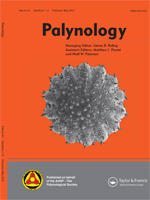Feng-Chun Yang, Paul J. Grote
Palynology 42 (2), 158-167, (1 April 2018) https://doi.org/10.1080/01916122.2017.1296044
KEYWORDS: pollen, vegetation, Mun River, Late Pleistocene, Khorat Plateau
The Khorat Plateau, at the centre of mainland Southeast Asia, is considered a bridge connecting the biotas of Indochina and Kalimantan. The vegetation change in this area is an indicator of regional environmental change, but the history is unclear. In this study, a sand pit along an ancient fluvial terrace on this plateau was investigated palynologically. An assemblage of Abies, Pinus, Chenopodiaceae and grass suggest a temperate forest and subtropical savannah 172,739 ± 22,400 and 88,661 ± 10,600 a BP, indicating a cold and dry environment. Deciduous and mixed forests indicate a warm period from 52,296 ± 6800 to 28,150 ± 7860 a BP, accompanied by aquatic components. An increase in mangrove abundance coincided with a rise in sea level. The period 27,332 ± 3000 a BP experienced a dry, cold environment. Conclusively, pollen records from the river terrace suggest tremendous vegetation change in the history of the Khorat Plateau.

